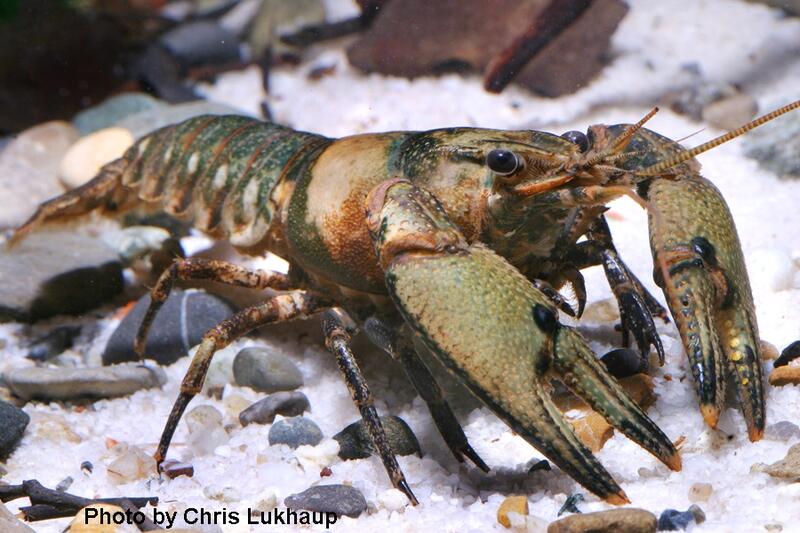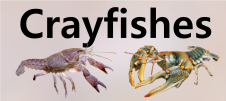







Loading profile. Please wait . . .
Faxonius spinosus (Bundy, 1877)
Coosa Spiny River Crayfish




Federal Protection: No US federal protection
State Protection: No Georgia state protection
Global Rank: G4
State Rank: S4
Element Locations Tracked in Biotics: No
SWAP 2015 Species of Greatest Conservation Need (SGCN): No
SWAP 2025 Species of Greatest Conservation Need (SGCN): No
2025 SGCN Priority Tier: None
Element Occurrences (EOs) in Georgia: 0
Habitat Summary for element in Georgia: Usually associated with rocks or woody debris in slower areas of streams, but sometimes found in riffle habitats
The overall color of the Coosa Spiny River Crayfish is light brown to olive with darker mottling. There is a dark band (blackish) in front of the areola and a dark olive band (saddle) behind the areola. The first one or two segments of the abdomen are dark and the remainder of the abdomen is olive-tan; there is a thin reddish line at the rear of each abdominal segment. The tips of the fingers of the claws are orangish and there is black pigment just behind the tips. There is an obvious black spot where the movable finger attaches to the palm, and the outside edge of the claw is black as well. There are two rows of tubercles along the mesial margin of the palm, and the claws often have so much setae as to appear hairy. The areola is fairly wide and shaped much like an hourglass. The rostrum is long, parallel-sided, and has a long sharp acumen and marginal spines or tubercles. There is a single well-developed cervical spine. This species reaches a maximum total body length of about 76 mm (3 in). Note: Based on data presented by Crandall and De Grave (2017), this species was removed from the genus Orconectes and placed in Faxonius.
Based on the prominent black spot where the movable finger attaches to the palm, the only species that could be confused with Coosa Spiny River Crayfish is the Reticulate Crayfish, Orconectes erichsonianus. These two species have never been collected together in Georgia, but have both been found in the Chattooga River system and Pine Log Creek which is a tributary to the Coosawattee River. Examination of the male first pleopod or the female annulus ventralis is required to separate these two species.
The Coosa Spiny River Crayfish is a stream dweller and is most often found beneath rocks or woody debris in slower moving areas of streams. It can be found in riffle areas as well (Hobbs 1981).
No studies of this species are known. Crayfishes are considered opportunistic omnivores and likely feed on live and decaying vegetation, aquatic insect larvae, small fishes, and dead animal matter.
Stream dwelling crayfishes typically hide during the day and come out at night to feed. Reproduction usually occurs during the spring and fall, but males in reproductive condition may be found at any time during the year. When female crayfish are ready to lay eggs, they usually find a secure hiding place and hence are rarely encountered. When the eggs are released, the female attaches them to her swimmerets and is said to be “in berry.” Upon hatching, the juvenile crayfish are attached to the mother by a thread. After the juveniles molt for the second time, they are free of the mother, but stay close and will hold on to her for some time. Eventually they move off on their own. Crayfishes molt 6 or 7 times during their first year of life and most are probably able to reproduce by the end of that year. They molt once or twice a year for the remainder of their lives and live about 3 years. Male Coosa River Spiny Crayfish in reproductive condition have been collected in April, August, September, and October. Six females carrying eggs were found in April and one with young in May; egg counts ranged from 89-286. The smallest male known is about 36 mm (1.4 in) and smallest female carrying eggs is about 45 mm (1.8 in) in length (Hobbs 1981).
Flipping larger rocks in just about any habitat in a stream should turn up this species. The animal can be pinned by hand or gently driven into a dipnet. Dipnetting through leaf packs, using a backpack electroshocker, or baited minnow traps set overnight could yield specimens as well.
The Coosa Spiny River Crayfish is known from the Tennessee River system in Tennessee and Alabama and the Coosa River system in Alabama, Georgia, and Tennessee. In the Tennessee system, it is found from the Buffalo River (Duck River system, TN), upstream through Alabama to the Elk River system of Tennessee. In the Coosa system it is found from the Conasauga River downstream to the Alabama-Georgia state line (Hobbs 1981, 1989).
Heavy sedimentation resulting from poor development and land management practices may cover substrates and other daytime hiding places on which crayfishes rely to avoid predation. The introduction of non-native crayfishes is a threat to all native crayfishes.
This species common and widespread and is apparently stable in Georgia.
Conserving populations of the Coosa Spiny River Crayfish will require general watershed level protection measures, including the protection of riparian zones, control of sediment and nutrient runoff from farms and construction sites, and limiting the amount of impervious cover (e.g., pavement) within occupied watersheds. Non-native crayfishes should never be used for bait; instead, anglers should use crayfishes collected from the river system where they will be fishing. Unused bait of any kind should not be released back into Georgia waters.
Crandall, K.A., and S. De Grave. 2017. An updated classification of the freshwater crayfishes (Decapoda: Astacidea) of the world, with a complete species list. Journal of Crustacean Biology 2017:1-39.
Hobbs, H.H., Jr. 1981. The crayfishes of Georgia. Smithsonian Contributions to Zoology 318:1–549.
Hobbs, H.H., Jr. 1989. An illustrated checklist of the American crayfishes (Decapoda: Astacidae, Cambaridae, and Parastacidae). Smithsonian Contributions to Zoology 480:1–236.
Taylor, C.A., G.A. Schuster, J.E. Cooper, R.J. DiStefano, A.G. Eversole, P. Hamr, H.H. Hobbs III, H.W. Robison, C.E. Skelton, and R.F. Thoma. 2007. A reassessment of the conservation status of crayfishes of the United States and Canada after 10+ years of increased awareness. Fisheries 32:372–389.
Christopher E. Skelton
C. Skelton, 2012: original account
C. Skelton, March 2019: general update of account.
D.Weiler, September 2019: photo added